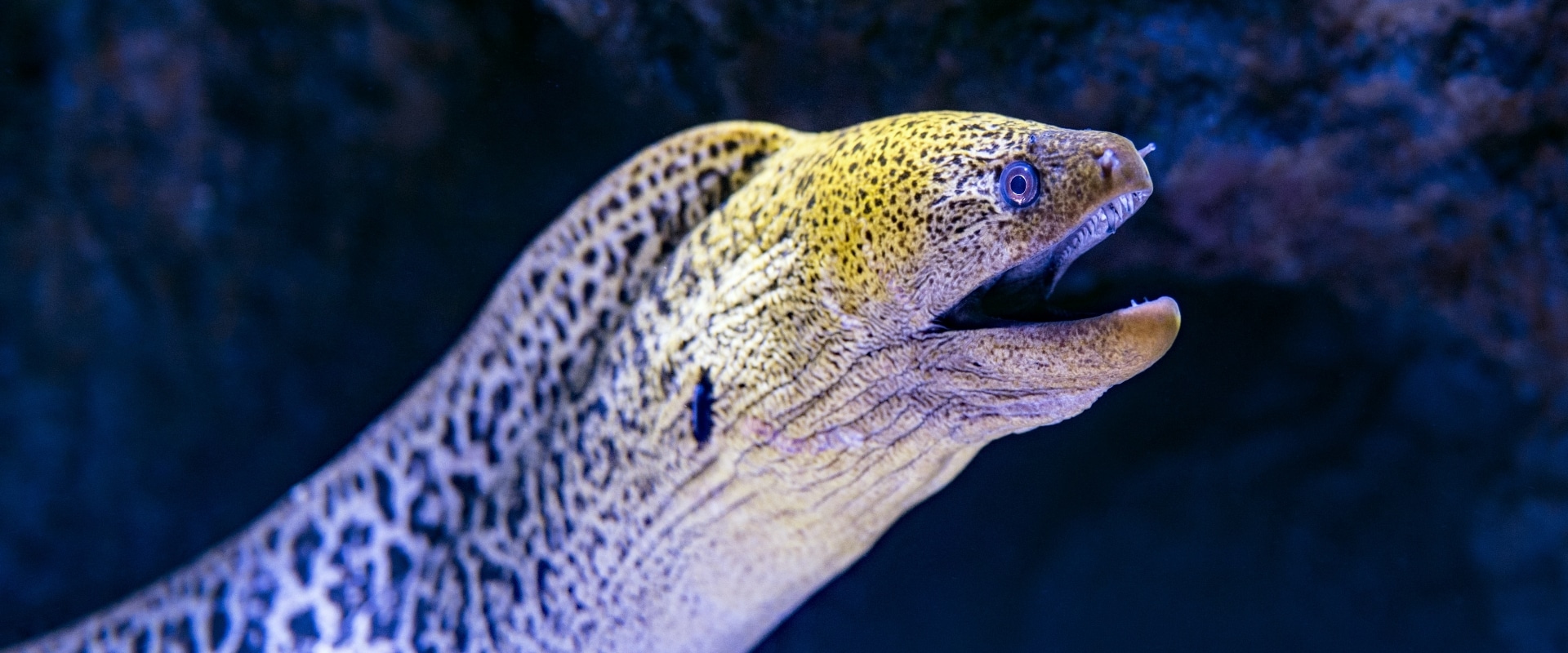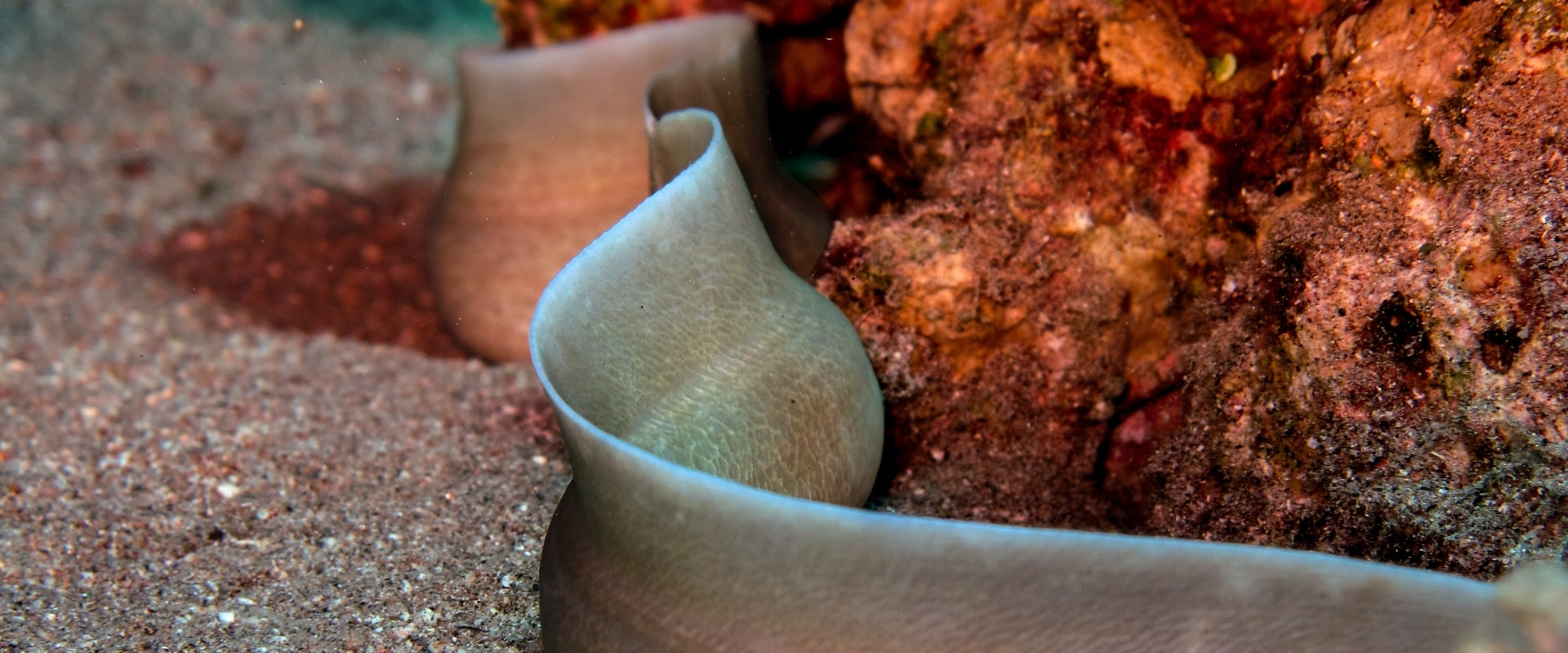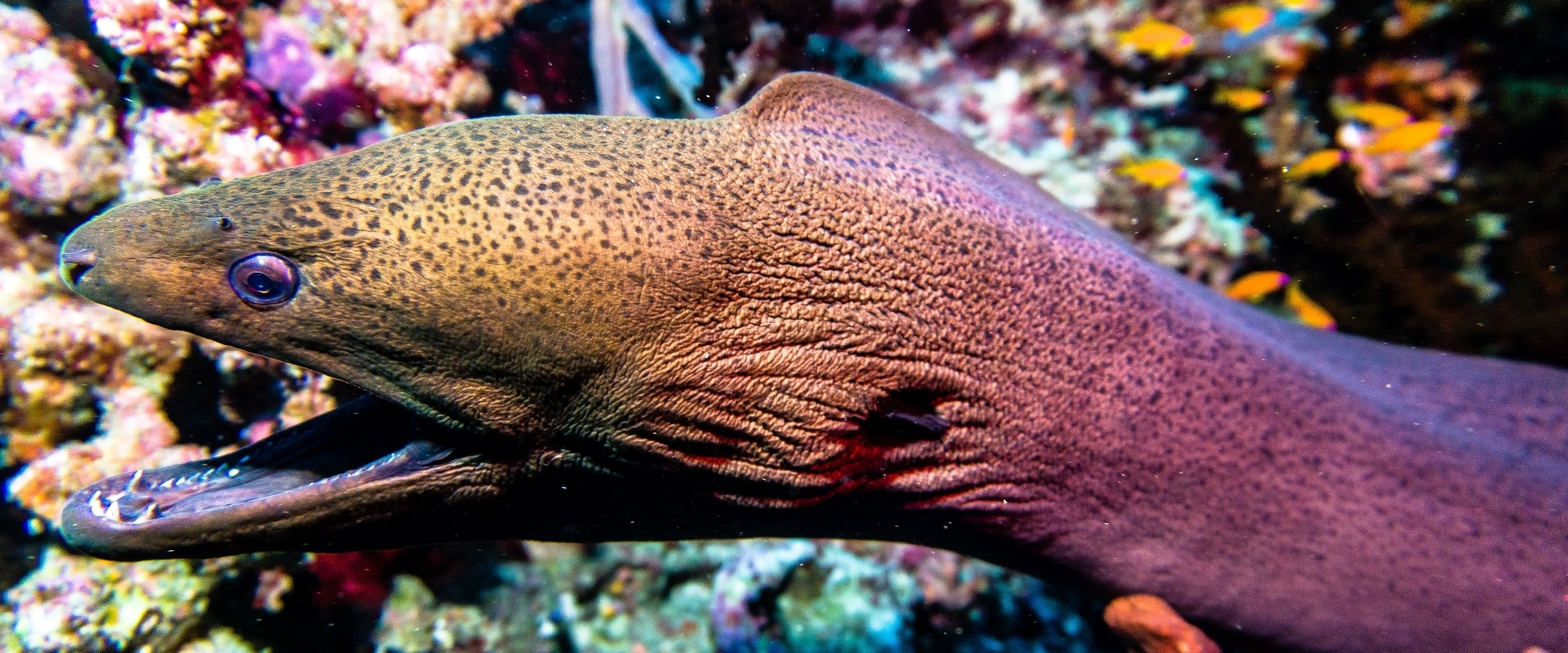Moray eels are straight out of science fiction films; but certainly not the pleasant kind. Morays are a family of eels that are found all over the globe. There are over 200 different species of Moray. And while they may vary in appearance, they all share one main characteristic: they are real creeps!
Scuba divers in Thailand are very likely to see a Moray Eel at some point during their dive. Generally, they are found deeper than snorkellers descend to. The Giant Moray Eel is just one of many species of Moray Eels found in Thailand. Every species of Moray Eel is distinctly different from other eels types. Today, we will get to know them some more.

What exactly are Moray Eels?
Moray Eel is any member of the Family Muraenidae, in the order of Anguilliformes. They vary in size from less than 15cm. to 3m. in length. They are found in temperate and tropical seas around the world, and also brackish water.
While they may look like they’re related to snakes, they’re actually just a type of fish that has evolved to survive in small and narrow crevices.
Unlike snakes, Moray eels are completely scaleless and have a dorsal fin that runs the length of their backs and joins with their caudal and anal fins. They do not have pectoral and pelvic fins and rely on a somewhat serpentine slithery movement to get around.

Moray Eels behaviour
Moray Eels are surprisingly shy creatures that spend most of the daytime in crevices of rocks, coral or other parts of the reef. They usually prefer to stay alone, but it’s not uncommon to see two or more Moray Eels together. However, this may not always be a friendly encounter.
One of the Morays typical behaviours that don’t help their creepy reputation is their constant opening and closing of their mouths. They do this to control a flow of oxygen-rich water to pass their gills, which are located next to their mouths. With their large sharp teeth, this makes them look aggressive when in fact they’re not.
They do not have swim bladders and are therefore not the best creatures for maintaining buoyancy.
Morays have very poor eyesight but an excellent sense of smell. They rely primarily on chemoreception to catch prey. They even have very visible nostrils. This strategy is due to the fact that they’re nocturnal and to see in the dark while underwater requires a certain visual awareness that Morays lack.
Morays are primarily ambushed hunters, lunging at prey as they pass by. But these lunges generate waves which can displace their prey, moving them out of their range. Cleverly, Morays have developed openings on either side of their large mouth, which allows for water to move through their mouths and prevent wave generation.
But Morays don’t only ambush, sometimes they chase. The giant Moray Eel has been observed teaming up with grouper and other fish on hunts. Groupers are open water hunters and their prey hides from them in coral. Giant Moray eels, on the other hand, live in coral, and their prey heads to open water to escape them. To initiate the team-up, grouper fish will find a giant Moray and shake its head. the Moray will leave its den and join the grouper on the hunt. If their prey is scared by the grouper, the Moray gets it. And if it’s scared by the Moray, the grouper gets it.
Morays have few predators, and the larger species are often the apex predators in their ecosystems. Grouper, barracuda, sharks, and humans are common predators of moray eels.
Morays live primarily in saltwater, though there are some species that can be found in brackish and freshwater.
And if you were wondering, Morays have been documented tying themselves into knots to create leverage to pull prey out of crevices.
Female Morays lay the eggs and the male fertilizes them. When they hatch, the larvae are free-swimming. But most interestingly, they are translucent.

Moray Eels Biological Characteristics
Many species of Moray have very large pointy teeth which they use to grab slippery fish. The most famous of these is the Fangtooth Moray Eel which has an elongated jaw to hold a frightening amount of sharp teeth.
Morays have two sets of Jaws, the regular, or Oral Jaws, are the ones with the big scary teeth. But they also have a second set called the Pharyngeal Jaws. This one sits in the throat of the Moray. And when the Moray catches its prey in its oral jaw the Pharyngeal shoots forward, grabs the prey, and pulls it down its throat. Morays are the only animal known to do this.
The California Moray even has teeth on the roof of its mouth to prevent their prey from moving sideways, making it easier for the Pharyngeal Jaws to do its work.
Though some species like the Snowflake Moray that specializes in crustaceans and other hard-shelled animals, and thus have blunt teeth which they use to crack open shrimp and crab shells.
Most species of Moray are patterned, and those patterns continue on the insides of their mouths.
Morays are covered in mucus, and in some species that mucus is toxic. Their skin is lined with cells called goblet cells, these produce mucus. They use this mucus to protect themselves from abrasions caused by the sharp edges of the rocks and coral they tend to dwell in. Different species are slimier than others, and some are slimier on different parts of their bodies depending on their behaviour.
Moray Eels begin life as Leptocephalus larvae and drift in open water before they become elders. They then grow into adult eels and can live for up to 30 years, depending on the species and its conditions. Some species die soon after mating.

Different Types of Moray Eels
Moray Eels found in Thailand include some common and rare species. Also, most have several common names, depending on who is referring to each species. In addition, there is often confusion about particular common names used for different species in other oceans. For example, there are different species around the world which share the common name of ‘Honeycomb Moray.’ In no particular order, the following species can all be found on Thailand’s west coast, particularly around The Similan Islands & Richelieu Rock.
The largest Moray eel is the Giant Moray which can reach up to 2.5 meters in length and weigh up to 30 kilograms. The smallest Moray is Snyders Moray, which measures just under 12 centimetres in length.
Laced / Honeycomb Moray Eel Is another large species, sometimes growing to nearly 3 metres in length. These eels are very attractive, as they are covered in dark spots like a leopard. In fact, some people also refer to this species like the Leopard Moray Eel. Divers at Boonsung Wreck are guaranteed to see plenty of Honeycomb Morays, regardless of the sea conditions or time of year.
Ribbon eels make burrows in the sand, and they use their mucus as a form of glue to hold the sand and their burrows together. Ribbon eels are one of the coolest types of Moray, though their place in the Moray family is up for debate. Ribbon eels have extended protruding nostrils which they can use to attract prey. They are believed to be hermaphrodites which means that they are born male and later in life become female. also with age, they developed their striking colours, juveniles are black, but as they age they become deep blue and yellow if they’re male, and entirely yellow if they’re female.
Zebra Moray Eel is a rare species in Thailand and often mistaken for two completely different species, the Banded Sea Krait & Snake Eel. Zebra Morays get their name from their black & white stripy patterns all the way down their length. It has short, blunt teeth which are ideal for catching crustaceans and sea urchins. They can grow to more than 1 metre in length, but not often.
Fimbriated Moray Eel has a striking appearance. It’s normally bright yellow or green in colour and has a longer snout than most other species. It can grow up to one metre in length over a lifespan up to 18 years. Fimbriated Moray Eels can be found near ports, harbours and in brackish water as well as coral reefs at depths from 7-50m.
White Mouth Moray Eel is a medium to large species of Moray that has quite a dark colouration but is covered in tiny white spots. Its common name comes from the inside of its mouth being white. It prefers shallower water than most other species of Moray, and juveniles can be seen in knee-deep water. They have quite a large head in comparison to other species.

Where Can Divers See Moray Eels in Thailand?
Dive sites in Thailand where you can see Moray Eels are too numerous to list here, but in particular at Richelieu Rock, it is almost guaranteed that divers will find at least two species. And nearer to Tab Lamu Pier and often the final stop off for many Similan liveaboard diving cruises, Boonsung Wreck. At Boonsung Wreck there are countless Honeycomb Moray Eels, and anyone diving there who doesn’t see several must be blind, have a fogged mask or be very distracted. There are individuals of other eels types at Boonsung Wreck, as well.

Come See Moray Eels in the Andaman Sea
KSA Liveaboard presents liveaboard trips to the North Andaman Route onboard the Manta Queen Fleet! Meet and greet Moray Eels, our beloved slithery fish. Explore distinct dive sites: Similan Islands, Koh Bon, Koh Tachai, Richelieu Rock, Surin Islands, and Boonsung Wreck! Join now for the ultimate liveaboard experience in Thailand with KSA Liveaboard! [BOOK NOW]
